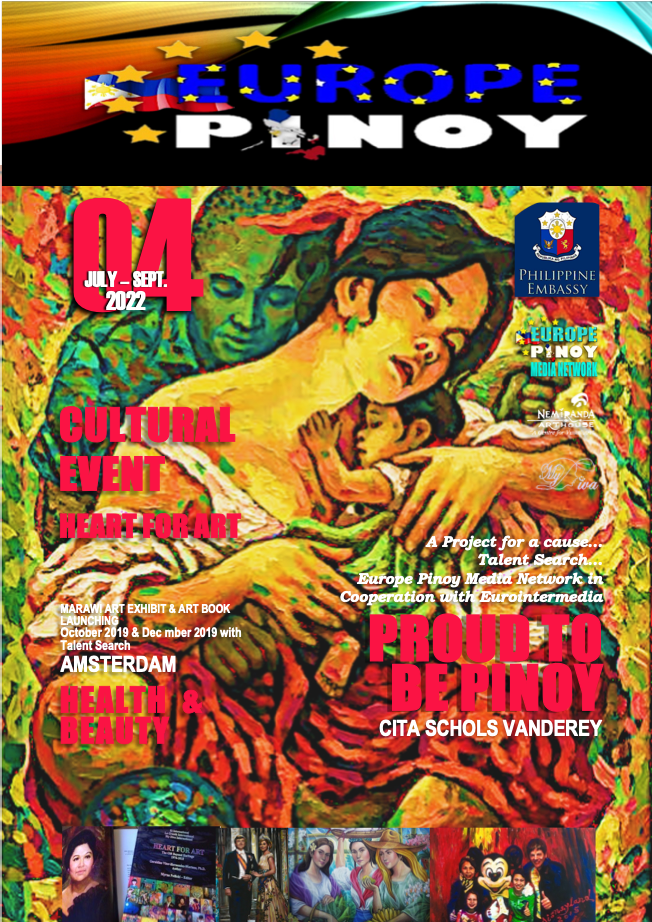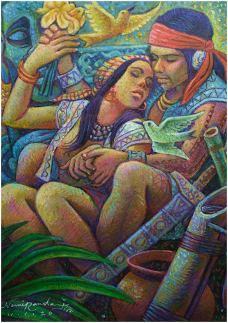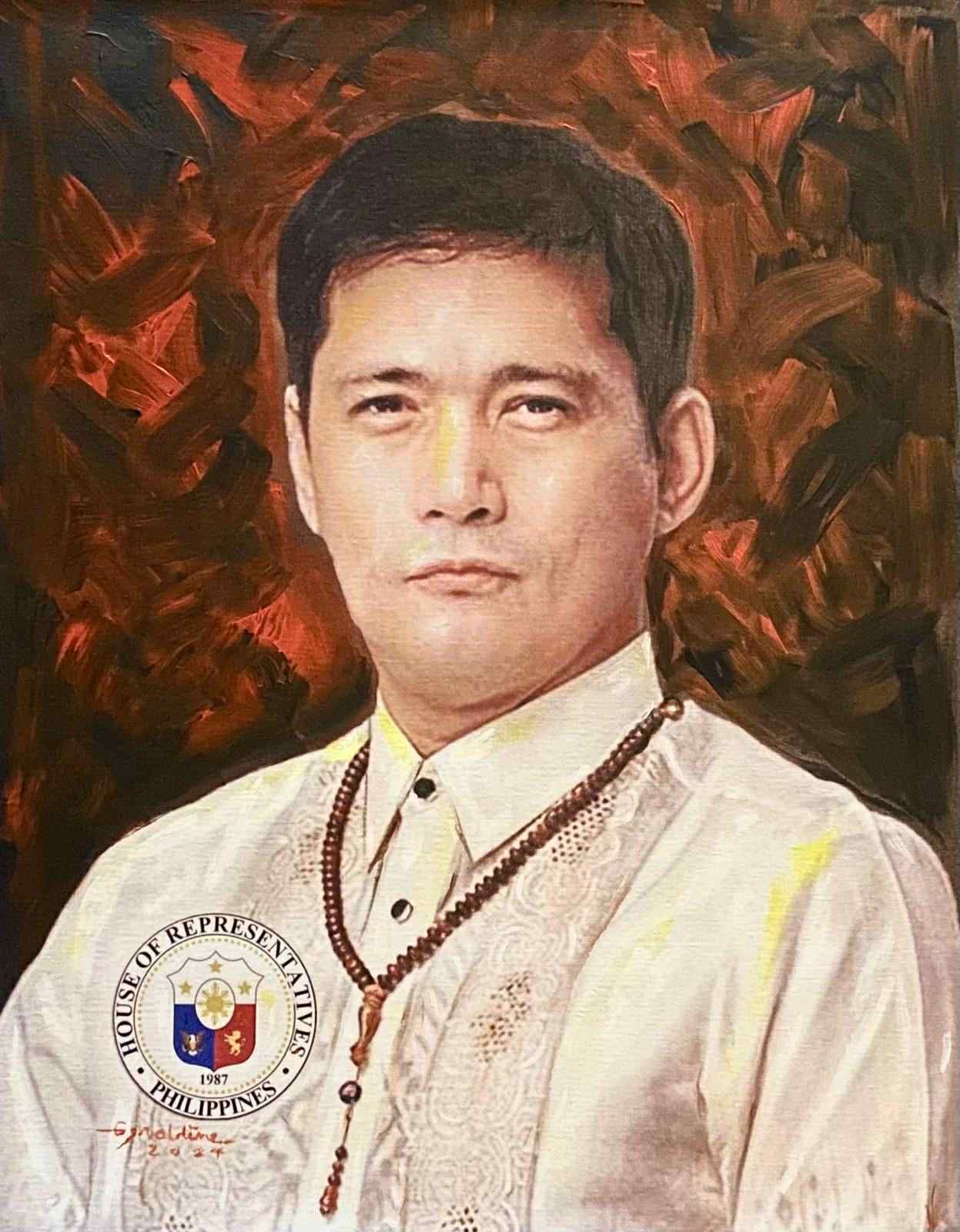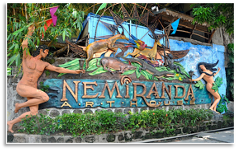NEMI R. MIRANDA, JR. Visual Art Journey - better known as NEMIRANDA is celebrating fifty (50) years as a full-time artist, both as sculptor and painter.
This multi-awarded and highly recognized Artist hails from Angono, Rizal known as the “ART CAPITAL OF THE PHILIPPINES.” He graduated with a Degree in Fine Arts, major in “Painting” at the University of Santo Thomas (UST) in 1970. His masterful skills to draw the Human Figure paved way for him to be given commission works doing concrete sculpture murals in the early years of his career. The best example of this was the 2m x 175m long mural at the Parade Ground of the Philippine Army at Fort Bonifacio, Taguig City in 1975 called the “HISTORY of the PHILIPPINE ARMY” in concrete sculpture.
He was also tagged as the Artist of the EDSA “People Power” Revolution in 1986, for his creation of the EDSA REVOLUTION Painting series, and as well as the mural of “TARMAC to EDSA” at the EDSA Shrine. Again in 2001, at the second EDSA REVOLUTION, another series of paintings and eventually a Bas-Relief Mural of EDSA DOS was commissioned to him at the outside wall of EDSA SHRINE at the corner of EDSA-ORTIGAS AVE.
Among his many worksalso noteworthy of mentioning are the ORTIGAS AND COMPANY MURAL in concrete sculpture at the Ortigas Park, Ortigas Center, The Way of Mary (20 Rosary Mysteries Shrine) from EDSA Shrine to Antipolo Shrine, a Painting Mural at the Altar of Antipolo Cathedral and a 3-D Mural Landmark called “THE DEFENDERS OF BATAAN” at Layac Dinalupihan Bataan, to name a few.
NEMIRANDA is so prolific that he was able to hold more than Eighty (80) Solo Art Exhibitions here and abroad, including hundreds of groups shows he participated in. He became known then in the Art Scene as the forerunner of an ART IDIOM called “IMAGINATIVE FIGURISM” for his mastery of the HUMAN FORM in pure Imagination. He was instrumental in developing his hometown Angono into an Artist Village, by organizing the yearly “ANGONO ART FESTIVAL”.
He also pursued his mission in creating an Art atmosphere for the whole province of Rizal, dubbed as the “RIZAL ART FESTIVAL” - now ongoing for its tenth (10th) year. Finally, he organized the "PHILIPPINE VISUAL ART FESTIVAL" which he led for three (3) consecutive years in Luzon, Visayas and Mindanao from 2012-2014, when he was Head of the Visual Arts Committee of the National Commission for Culture and the Arts (NCCA).
NEMIRANDA was a member of the Stamp Committee of the Philippine Postal Corporation (PHILPOST) for more than six (6) years (2012-2018). The colorful life of NEMIRANDA as an artist speaks well of his many awards and recognition, an accolade he has achieved for fifty (50) long creative years.
To describe him as a whole, he is noted to be the Philippines’ Father of Imaginative Figurism, a Visual Historian, a Teacher, an Art Leader, a Scouter, a Rotarian and a Cultural worker promoting the Filipino Traditions, Culture and our Local Myths and Legends to the world. In many occasions this artist has always been addressed as the “LIVING LEGEND OF ANGONO”.
IMAGING LAPU-LAPU
Very few accounts of Lapu-Lapu’s Historical notes can be found even in our Historical achieves. Only on Pigafettas book of Magellan’s expedition had some few notes on the Battle of Mactan. On his notes, Magellan sent an emissary to Lapu-Lapu to pay tribute to the King of Spain, but Lapu-Lapu decline Magellan’s offer.
The chieftain of the neighboring Barangay who had much jealousy of Lapu-Lapu approach, Magellan, bringing three goats as a gift. He told Magellan that he should punish Lapu-Lapu for his insubordination to Spanish majesty. He even offered his native warriors to help and assist them if they push through in conquering Lapu-Lapu’s strong-armed warriors.
So, on the eve of April 26 night, Magellan gave a gift of the image of Sto. Niño to the Queen Juana of Cebu, where his army was already preparing to sail on Mactan Island to invade Lapu-Lapu together with the chieftain who betrayed Lapu-Lapu, However, Lapu-Lapu knowing of this plan, so he prepared his men and kept waiting and the rest was a history that Magellan fell and died on the shore of Mactan, by the sword of Lapu-Lapu.
This exhibit titled “IMAGING LAPULAPU” is just an Artist’s portrayal of who could be the real Lapu-Lapu. Since we have little knowledge of who he really is as a whole person. Through this may be some thoughts of the Artists wild imagination may be very close to the true life of Lapu-Lapu being an ordinary human being based on how we know of Lapu-Lapu as a great warrior and a great leader of his kingdom.
From there we could easily conclude he has a good management skill in handling peace and order, in bringing livelihood to the community, in food production in giving importance to education especially to young children. He could have focused on training the young for mountain survival and self-defense in preparing them to become good leaders and future soldiers. So as a true leader he could have lived by example. He was a farmer, a carpenter, a blacksmith, a trader, an entrepreneur, a fisherman, a sailor. To sum it all we could conclude Lapu-Lapu was a true leader and an excellent warrior. But how about his personal life?
As a young man, he had also some passion. He sings, plays a musical instrument, dance, and does some carvings. He was in love, court her, serenade her and in the end marry her as in ordinary love story they loved, got married, lived together, and had a family. From this artist’s wild imagination, now we see a bigger picture of a great man considered as the First National Hero of the Maharlikan now Filipino race.
These series of images crafted by the artist wild imagination may be true or lies. Who knows? Confused between truth and lies we may find the TRUTH….
Written by FREDERICK ALAIN DOCDOCIL
Here is is one of the many different Creation Myths from the Philippines. When the world first began there was no land; there was only the Sea and the Sky, and between them flew a huge, beautiful Kite (a bird similar to a hawk). One day, the bird, which had nowhere to land and rest, grew tired of flying about, and in frustration stirred up the Sky in a quarrel against the Sea. The Sky threw rain, thunder, and lightning that reached the Sea, who in turn rose up and hurled waves and hurricanes that reached the Sky.
In order to restrain its fury, the Sky showered a multitude of massive boulders down upon the Sea, which became the islands that formed the Philippines. These islands prevented the waters from rising any more - instead causing them to flow back and forth, and thereby creating the tides. Afterwards, the Sky then ordered the Kite to light on one of the newly-formed islands to build her nest, and to leave the Sea and the Sky in peace. Now at this same time the Land Breeze and the Sea Breeze were married, and they had a child which they named Bamboo. One day, when Bamboo was floating against the sea, it struck the feet of the Kite. Shocked, hurt, and angered that anything should strike it, the bird furiously pecked at the bamboo until it split in half. Out of one section came a golden-bronze colored man, named Malakas (Strong One) and from the other half came a similarly hued woman, named Maganda (Beautiful One).
The earthquake then called on all the birds of the sky and the fish of the sea to see what should be done with these two, and the animals decided that they should marry each other. Together, Malakas and Maganda had many children, and from them eventually came all the different races of people.
After a while the parents grew very tired of having so many idle and useless children around. They wished to be rid of them, but they knew of no other place to send them off to. Time
went on and the children became even more numerous that the parents could no longer enjoy any peace. One day, in an act of pure irritation and desperation, Malakas seized a stick and began beating them on all sides.
This so frightened the children that they all fled in different directions; seeking some place to hide both within and outside the house. Some of the children ran into hidden rooms in the house, several concealed themselves within the actual walls, while others hid in the fireplace. Some ran outside and the rest fled out to the sea.
Now it happened that those who went into the hidden rooms of the house later became the chiefs of the islands (Maharlikas); and those who concealed themselves in the walls became slaves (Alipins). Those who hid in the fireplace became the Negritos and the Aetas; and those who ran outside turned into free men (Timawas). As for those who fled to the Sea; they were gone many years, and when their children eventually came back, they had become the white foreigners. Because the Philippines has so many islands and is inhabited by different ethnic groups, Philippine mythology and superstitions are very diverse. Even the story of Malakas and Maganda vary from region to region, but specific elements of the story remain the same: there is a huge bird that splits a giant bamboo, and Malakas and Maganda emerge from the halves. The names Malakas and Maganda also denote a deeper meaning and truth about Pilipino culture.
Pilipinos consider women to be maganda - beautiful, sweet, and soft; while men as malakas - a strong and sturdy being to whom the family can depend on at all times.
The final part about the children who fled out to the sea and eventually came back as “white foreigners” seems to have been added to the original version that had been handed down orally over the years from generation to generation.
Click this for more info Nemiranda Arthouse.























